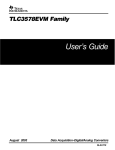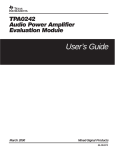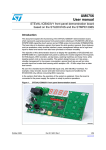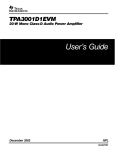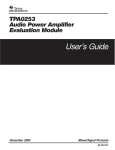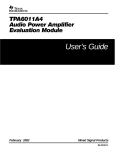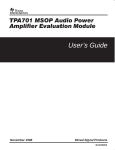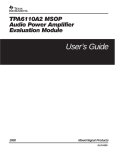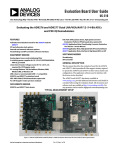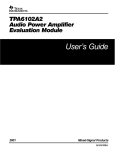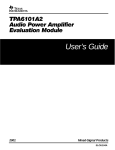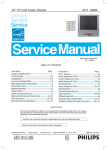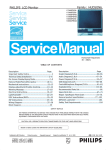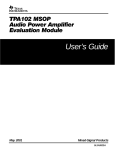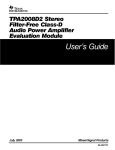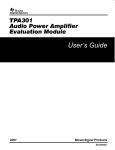Download Texas Instruments TPA6030A4 User's Manual
Transcript
User’s Guide November 2002 Mixed-Signal Products SLOU113A IMPORTANT NOTICE Texas Instruments Incorporated and its subsidiaries (TI) reserve the right to make corrections, modifications, enhancements, improvements, and other changes to its products and services at any time and to discontinue any product or service without notice. Customers should obtain the latest relevant information before placing orders and should verify that such information is current and complete. All products are sold subject to TI’s terms and conditions of sale supplied at the time of order acknowledgment. TI warrants performance of its hardware products to the specifications applicable at the time of sale in accordance with TI’s standard warranty. Testing and other quality control techniques are used to the extent TI deems necessary to support this warranty. Except where mandated by government requirements, testing of all parameters of each product is not necessarily performed. TI assumes no liability for applications assistance or customer product design. Customers are responsible for their products and applications using TI components. To minimize the risks associated with customer products and applications, customers should provide adequate design and operating safeguards. TI does not warrant or represent that any license, either express or implied, is granted under any TI patent right, copyright, mask work right, or other TI intellectual property right relating to any combination, machine, or process in which TI products or services are used. Information published by TI regarding third–party products or services does not constitute a license from TI to use such products or services or a warranty or endorsement thereof. Use of such information may require a license from a third party under the patents or other intellectual property of the third party, or a license from TI under the patents or other intellectual property of TI. Reproduction of information in TI data books or data sheets is permissible only if reproduction is without alteration and is accompanied by all associated warranties, conditions, limitations, and notices. Reproduction of this information with alteration is an unfair and deceptive business practice. TI is not responsible or liable for such altered documentation. Resale of TI products or services with statements different from or beyond the parameters stated by TI for that product or service voids all express and any implied warranties for the associated TI product or service and is an unfair and deceptive business practice. TI is not responsible or liable for any such statements. Mailing Address: Texas Instruments Post Office Box 655303 Dallas, Texas 75265 Copyright 2002, Texas Instruments Incorporated EVM IMPORTANT NOTICE Texas Instruments (TI) provides the enclosed product(s) under the following conditions: This evaluation kit being sold by TI is intended for use for ENGINEERING DEVELOPMENT OR EVALUATION PURPOSES ONLY and is not considered by TI to be fit for commercial use. As such, the goods being provided may not be complete in terms of required design-, marketing-, and/or manufacturing-related protective considerations, including product safety measures typically found in the end product incorporating the goods. As a prototype, this product does not fall within the scope of the European Union directive on electromagnetic compatibility and therefore may not meet the technical requirements of the directive. Should this evaluation kit not meet the specifications indicated in the EVM User’s Guide, the kit may be returned within 30 days from the date of delivery for a full refund. THE FOREGOING WARRANTY IS THE EXCLUSIVE WARRANTY MADE BY SELLER TO BUYER AND IS IN LIEU OF ALL OTHER WARRANTIES, EXPRESSED, IMPLIED, OR STATUTORY, INCLUDING ANY WARRANTY OF MERCHANTABILITY OR FITNESS FOR ANY PARTICULAR PURPOSE. The user assumes all responsibility and liability for proper and safe handling of the goods. Further, the user indemnifies TI from all claims arising from the handling or use of the goods. Please be aware that the products received may not be regulatory compliant or agency certified (FCC, UL, CE, etc.). Due to the open construction of the product, it is the user’s responsibility to take any and all appropriate precautions with regard to electrostatic discharge. EXCEPT TO THE EXTENT OF THE INDEMNITY SET FORTH ABOVE, NEITHER PARTY SHALL BE LIABLE TO THE OTHER FOR ANY INDIRECT, SPECIAL, INCIDENTAL, OR CONSEQUENTIAL DAMAGES. TI currently deals with a variety of customers for products, and therefore our arrangement with the user is not exclusive. TI assumes no liability for applications assistance, customer product design, software performance, or infringement of patents or services described herein. Please read the EVM User’s Guide and, specifically, the EVM Warnings and Restrictions notice in the EVM User’s Guide prior to handling the product. This notice contains important safety information about temperatures and voltages. For further safety concerns, please contact the TI application engineer. Persons handling the product must have electronics training and observe good laboratory practice standards. No license is granted under any patent right or other intellectual property right of TI covering or relating to any machine, process, or combination in which such TI products or services might be or are used. Mailing Address: Texas Instruments Post Office Box 655303 Dallas, Texas 75265 Copyright 2002, Texas Instruments Incorporated EVM WARNINGS AND RESTRICTIONS It is important to operate this EVM within the supply voltage range of 7 V to 15 V. Exceeding the specified input range may cause unexpected operation and/or irreversible damage to the EVM. If there are questions concerning the input range, please contact a TI field representative prior to connecting the input power. Applying loads outside of the specified output range may result in unintended operation and/or possible permanent damage to the EVM. Please consult the EVM User’s Guide prior to connecting any load to the EVM output. If there is uncertainty as to the load specification, please contact a TI field representative. During normal operation, some circuit components may have case temperatures greater than 85°C. The EVM is designed to operate properly with certain components above 85°C as long as the input and output ranges are maintained. These components include but are not limited to linear regulators, switching transistors, pass transistors, and current sense resistors. These types of devices can be identified using the EVM schematic located in the EVM User’s Guide. When placing measurement probes near these devices during operation, please be aware that these devices may be very warm to the touch. Mailing Address: Texas Instruments Post Office Box 655303 Dallas, Texas 75265 Copyright 2002, Texas Instruments Incorporated Preface Read This First How to Use This Manual This document contains the following chapters: - Chapter 1—Introduction - Chapter 2—Quick Start - Chapter 3—Reference Information About Cautions and Warnings This book may contain cautions and warnings. This is an example of a caution statement. A caution statement describes a situation that could potentially damage your software or equipment. This is an example of a warning statement. A warning statement describes a situation that could potentially cause harm to you. The information in a caution or a warning is provided for your protection. Please read each caution and warning carefully. Read This First v Related Documentation From Texas Instruments Related Documentation From Texas Instruments J TI Plug-N-Play Audio Amplifier Evaluation Platform (literature number SLOU011) provides detailed information on the evaluation platform and its use with TI audio evaluation modules. J TPA6030A4 3-W Stereo Audio Power Amplifier With Advanced DC Volume Control (literature number SLOS395). This is the data sheet for the TPA6030A4 audio amplifier integrated circuit. FCC Warning This equipment is intended for use in a laboratory test environment only. It generates, uses, and can radiate radio frequency energy and has not been tested for compliance with the limits of computing devices pursuant to subpart J of part 15 of FCC rules, which are designed to provide reasonable protection against radio frequency interference. Operation of this equipment in other environments may cause interference with radio communications, in which case the user at his own expense will be required to take whatever measures may be required to correct this interference. vi Running Title—Attribute Reference Contents 1 Introduction . . . . . . . . . . . . . . . . . . . . . . . . . . . . . . . . . . . . . . . . . . . . . . . . . . . . . . . . . . . . . . . . . . . . . 1.1 Feature Highlights . . . . . . . . . . . . . . . . . . . . . . . . . . . . . . . . . . . . . . . . . . . . . . . . . . . . . . . . . . 1.2 Description . . . . . . . . . . . . . . . . . . . . . . . . . . . . . . . . . . . . . . . . . . . . . . . . . . . . . . . . . . . . . . . . 1.3 TPA6030A4EVM Specifications . . . . . . . . . . . . . . . . . . . . . . . . . . . . . . . . . . . . . . . . . . . . . . . 1.4 Special Notes Regarding the Data Sheet . . . . . . . . . . . . . . . . . . . . . . . . . . . . . . . . . . . . . . 1-1 1-2 1-3 1-3 1-4 2 Quick Start . . . . . . . . . . . . . . . . . . . . . . . . . . . . . . . . . . . . . . . . . . . . . . . . . . . . . . . . . . . . . . . . . . . . . . 2.1 Precautions . . . . . . . . . . . . . . . . . . . . . . . . . . . . . . . . . . . . . . . . . . . . . . . . . . . . . . . . . . . . . . . . 2.2 Quick Start List for Platform . . . . . . . . . . . . . . . . . . . . . . . . . . . . . . . . . . . . . . . . . . . . . . . . . . 2.3 Quick Start List for Stand-Alone . . . . . . . . . . . . . . . . . . . . . . . . . . . . . . . . . . . . . . . . . . . . . . 2-1 2-3 2-4 2-6 3 Reference . . . . . . . . . . . . . . . . . . . . . . . . . . . . . . . . . . . . . . . . . . . . . . . . . . . . . . . . . . . . . . . . . . . . . . . 3.1 TPA6030A4EVM Layout and Schematic . . . . . . . . . . . . . . . . . . . . . . . . . . . . . . . . . . . . . . . 3.2 TPA6030A4 Audio Power Amplifier Evaluation Module Parts List . . . . . . . . . . . . . . . . . . 3.3 Volume Control . . . . . . . . . . . . . . . . . . . . . . . . . . . . . . . . . . . . . . . . . . . . . . . . . . . . . . . . . . . . . 3-1 3-2 3-4 3-5 Figures 1–1 2–1 2–2 2–3 2–4 2–5 3–1 3–2 3–3 The TI TPA6030A4 Audio Amplifier Evaluation Module . . . . . . . . . . . . . . . . . . . . . . . . . . . . . Quick Start Platform Map . . . . . . . . . . . . . . . . . . . . . . . . . . . . . . . . . . . . . . . . . . . . . . . . . . . . . . Module Preparation . . . . . . . . . . . . . . . . . . . . . . . . . . . . . . . . . . . . . . . . . . . . . . . . . . . . . . . . . . . Quick Start Module Map . . . . . . . . . . . . . . . . . . . . . . . . . . . . . . . . . . . . . . . . . . . . . . . . . . . . . . . TPA6030A4EVM Connected for Stereo Bridge-Tied Load (BTL) Output . . . . . . . . . . . . . . TPA6030A4EVM Connected for Stereo Single-Ended (SE) Output . . . . . . . . . . . . . . . . . . . TPA6030A4EVM Top Layer . . . . . . . . . . . . . . . . . . . . . . . . . . . . . . . . . . . . . . . . . . . . . . . . . . . . TPA6030A4EVM Bottom Layer . . . . . . . . . . . . . . . . . . . . . . . . . . . . . . . . . . . . . . . . . . . . . . . . . TPA6030A4EVM Schematic . . . . . . . . . . . . . . . . . . . . . . . . . . . . . . . . . . . . . . . . . . . . . . . . . . . . Contents 1-3 2-3 2-5 2-6 2-8 2-8 3-2 3-2 3-3 vii Running Title—Attribute Reference Tables 2–1 2–2 2–3 2–4 2–5 3–1 3–2 viii Typical TI Plug-N-Play Platform Jumper and Switch Settings for the TPA6030A4 . . . . . . Typical TPA6030A4EVM Jumper Settings . . . . . . . . . . . . . . . . . . . . . . . . . . . . . . . . . . . . . . . . Platform Jumper and Switch Settings for the TPA6030A4 . . . . . . . . . . . . . . . . . . . . . . . . . . . Typical TPA6030A4EVM Jumper Settings for BTL Stand-Alone . . . . . . . . . . . . . . . . . . . . . Typical TPA6030A4EVM Jumper Settings for SE Stand-Alone . . . . . . . . . . . . . . . . . . . . . . TPA6030A4EVM Parts List . . . . . . . . . . . . . . . . . . . . . . . . . . . . . . . . . . . . . . . . . . . . . . . . . . . . . Volume Control (VCC = 12 V, No Load, SEDIFF = 0 V, SEMAX = 5VREF) . . . . . . . . . . . . 2-2 2-2 2-4 2-8 2-8 3-4 3-5 Chapter 1 Introduction This chapter provides an overview of the Texas Instruments (TI) TPA6030A4 audio amplifier evaluation module (SLOP365). It includes a list of EVM features, a brief illustrated description of the module, and a list of EVM specifications. Topic Page 1.1 Feature Highlights . . . . . . . . . . . . . . . . . . . . . . . . . . . . . . . . . . . . . . . . . . . . 1–2 1.2 Description . . . . . . . . . . . . . . . . . . . . . . . . . . . . . . . . . . . . . . . . . . . . . . . . . . . 1–3 1.3 TPA6030A4EVM Specifications . . . . . . . . . . . . . . . . . . . . . . . . . . . . . . . . . 1–3 1.4 Special Notes Regarding the Data Sheet . . . . . . . . . . . . . . . . . . . . . . . . 1–4 1-1 Feature Highlights 1.1 Feature Highlights The TI TPA6030A4 audio amplifier evaluation module and the TI Plug-N-Play audio amplifier evaluation platform include the following features: - TPA6030A4 3-W stereo audio power amplifier evaluation module J Fully differential operation and internal depop circuitry to minimize transients in outputs J 3 W per channel output power into 16 Ω, BTL, at VCC = 12 V J Low current consumption in shutdown mode (1 µA) J Internal input mux selects among two sets of stereo inputs J Stereo, bridge-tied load (BTL) or single-ended (SE) operation J DC voltage volume control from 36 dB to –40 dB, and a –80 dB mute J SE gain adjustable from 30 dB to –46 dB, and a –86 dB mute - Quick and easy configuration with the TI Plug-N-Play audio amplifier eval- uation platform J Evaluation module is designed to simply plug into the platform, automatically making all signal and power connections J Platform provides flexible power options J Jumpers on the platform select power and module control options J Switches on the platform route signals J Platform provides quick and easy audio input and output connections - Platform power options J External 5-V to 15-V dc VCC supply inputs J External regulated VDD supply input J Socket for onboard 5 V/3.3 V VDD voltage regulator EVM J Onboard overvoltage and reverse polarity power protection - Platform audio input and output connections 1-2 J Left and right RCA phono jack inputs J Miniature stereo phone jack input J Left and right RCA phono jack outputs J Left and right compression speaker terminal outputs J Miniature stereo headphone jack output Introduction Description 1.2 Description The TPA6030A4 stereo 3-W audio power amplifier evaluation module is designed to demonstrate all of the different features and benefits of the TPA6030A4 amplifier. It consists of the TI TPA6030A4 stereo 3-W audio power amplifier IC along with a small number of other parts mounted on a circuit board that measures approximately 2 1/4 inches by 1 1/2 inches (Figure 1–1). Figure 1–1. The TI TPA6030A4 Audio Amplifier Evaluation Module Single in-line header pins extend from the underside of the module circuit board to allow the EVM to be plugged into the TI Plug-N-Play audio amplifier evaluation platform, or to be wired directly into existing circuits and equipment when used stand-alone. The platform has room for a single TPA6030A4 evaluation module and is a convenient vehicle for demonstrating TI’s audio power amplifier and related evaluation modules. The EVM simply plugs into the platform, which automatically provides power to the modules, interconnects them correctly, and connects them to a versatile array of standard audio input and output jacks and connectors. Easy-to-use configuration controls allow the platform and EVMs to quickly model many possible end-equipment configurations. There is nothing to build, nothing to solder, and nothing but the speakers included with the platform to hook up. 1.3 TPA6030A4EVM Specifications Supply voltage range, VCC . . . . . . . . . . . . . . . . . . . . . . . . . . . . . . . . 7 V to 15 V Supply current, IDD . . . . . . . . . . . . . . . . . . . . . . . . . . . . . . . . . . . . . . . . . 2 A max Continuous output power per channel, PO: 16-Ω BTL, VCC = 12 V . . . . . 3 W Audio input voltage, VI,: HP input . . . . . . . . . . . . . . . . . . . . . . . . VCC + 0.3 V LINE input . . . . . . . . . . . . . . . . . . . . . . VCC + 0.3 V Minimum load impedance, RL . . . . . . . . . . . . . . . . . . . . . . . . . . . . . . . . . . . 8 Ω† † VCC = 7 V is recommended for this load. Introduction 1-3 Special Notes Regarding the Data Sheet 1.4 Special Notes Regarding the Data Sheet The TPA6036A4EVM may have markings not consistent with the data sheet. Some EVMs have an incorrect supply voltage marked on them. The correct supply range is 7 V to 15 V, not 5 V to 15 V. The EVM and this user’s guide refer to the two input pins as HP and LINE, and refer to the control pin as HP/LINE. The data sheet refers to the two inputs as IN2 and IN1, respectively, and the control pin as IN2/IN1. See the data sheet for the correct voltages and pin names. 1-4 Introduction Chapter 2 Quick Start The steps in this chapter can be followed to quickly prepare the TPA6030A4 audio amplifier EVM for use. Using the TPA6030A4 with the TI Plug-N-Play audio amplifier evaluation platform is a quick and easy way to connect power, signal and control inputs, and signal outputs to the EVM using standard connectors. However, the audio amplifier evaluation module can be used stand-alone by making connections directly to the module pins, and can be wired directly into existing circuits or equipment. The TI Plug-N-Play platform supplies a 5-V regulated voltage that is designed to allow devices with an SE/BTL pin to automatically switch to SE output mode when a headphone is inserted into the headphone jack. The SE/BTL pin on the TPA6030A4 is designed to switch high when the voltage applied to the pin meets or exceeds 0.8 VCC, requiring a minimum of 5.6 V when the power supply is at 7 V. This is more than the platform can supply, and consequently, the automatic SE/BTL toggle feature of the TI Plug-N-Play platform is not fully compatible with the TPA6030A4EVM. However, the output mode can be manually changed with the use of J1 on the TPA6030A4EVM (see Table 2–2). Refer to the application section of the TPA6030A4 data sheet for more information about building a circuit that automatically switches output modes when a headphone is inserted. The jumper and switch settings on the TI Plug-N-Play platform do not change with different VCC levels. Topic Page 2.1 Precautions . . . . . . . . . . . . . . . . . . . . . . . . . . . . . . . . . . . . . . . . . . . . . . . . . . 2–3 2.2 Quick Start List for Platform . . . . . . . . . . . . . . . . . . . . . . . . . . . . . . . . . . . 2–4 2.3 Quick Start List for Stand-Alone . . . . . . . . . . . . . . . . . . . . . . . . . . . . . . . . 2–6 Quick Start 2-1 Table 2–1. Typical TI Plug-N-Play Platform Jumper and Switch Settings for the TPA6030A4 EVM JP5 JP6 JP7 JP8 S2 S3 P-N-P Platform OFF Mode X X Note 4 X Notes: 1) X = Don’t care 2) ON = Shunt installed 3) OFF = Open 4) Set S2 to ON when signal conditioning board is installed in U1; set S2 to OFF when no signal conditioning board is installed. Table 2–2. Typical TPA6030A4EVM Jumper Settings EVM TPA6030A4 Notes: Mode J1 J2 J3 BTL OFF X OFF SE ON X OFF 1) ON = Shunt installed 2) OFF = Open 3) X = Don’t care 2-2 Quick Start Precautions 2.1 Precautions Power Supply Input Polarity and Maximum Voltage Always ensure that the polarity and voltage of the external power connected to VCC power input connector J1, J2, and/or VDD power input connector J6 are correct. Overvoltage or reverse-polarity power applied to these terminals can open onboard soldered-in fuses and cause other damage to the platform, installed evaluation modules, and/or the power source. Inserting or Removing EVM Boards Do not insert or remove EVM boards with power applied—damage to the EVM board, the platform, or both may result. Figure 2–1. Quick Start Platform Map 1 C1+ On Off VR2 F2 U6 + + Right – Out U3 Off S2 J4 Stereo In U2 U1 J9 4 Left Out + Stereo Headphone Output HP Out J10 + S3 HP Source R4 Spk(U2-U4) C3 C2 JP8 U5 JP7 HP(U5) U2-U4 R3 + JP6 U4 U5 GND TP1 TEXAS INSTRUMENTS 1997 Plug-N-Play Audio Amplifier Evaluation Platform SLOP097 Rev. C.1 9 Speaker Output – Left Out On Conditioning J5 Left In Mode Mute Polarity Lo Hi ****CAUTION**** Do not insert or remove EVM boards with power applied 3 J8 J7 Right Out LED2 VDD Audio Power Amps DC Power In/Out J6 VDD In/Out R2 JP5 IDD LED1 VCC R1 Audio Input 8 POWER B1 SUPPLY S1 D1 D2 D3 J3 Right In 5 Signal Conditioning 7 ICC JP4 VR1 Pwr J1 JP3 Batt JP2 AC/DC JP1 (J2) VCC(J1) DC SOURCE D4 J2 AC/DC In Power Input VCC In + 6 F1 R5 2 Quick Start 2-3 Quick Start List for Platform 2.2 Quick Start List for Platform Follow these steps when using the TPA6030A4EVM with the TI Plug-N-Play audio amplifier evaluation platform (see the platform user’s guide, SLOU011, for additional details). Numbered callouts for selected steps are shown in Figure 2–1 and Figure 2–2: Note: The TI Plug-N-Play platform sends the input signal to both the HP and LINE inputs automatically, and only to the positive inputs. To fully take advantage of the TPA6030A4 differential input as well as the input mode selectable mux, the EVM should be used in a stand-alone fashion. - Platform Preparations 1) Ensure that all external power sources are set to OFF and that the platform power switch S1 is set to OFF. 2) Install a TPA6030A4 module in platform socket U2, taking care to align the module pins correctly. 3) Use switch S2 to select or bypass the signal conditioning EVM (U1). 4) Set jumper JP6 to select the Mode control input. 5) Remove jumper JP5. Table 2–3. Platform Jumper and Switch Settings for the TPA6030A4 EVM JP5 JP6 JP7 JP8 S2 S3 P-N-P Platform Off Mode X Hi Note 4 X Notes: 1) X = Don’t care 2) ON = Shunt installed 3) OFF = Open 4) Set S2 to ON when signal conditioning board is installed in U1; set S2 to OFF when no signal conditioning board is installed. - Power Supply 6) Select and connect an external regulated power supply (ensure power supply is turned OFF) set from 7 V to 15 V to platform VCC power input connector J1, taking care to observe marked polarity. Jumper the appropriate power input. - Inputs and Outputs 7) Ensure that the audio signal source level is set to minimum. 8) Connect the audio source to left and right RCA phono jacks J3 and J5 or stereo miniature phone jack J4. 9) Connect speakers to left and right RCA jacks J7 and J9 or to stripped wire speaker connectors J8. 2-4 Quick Start Quick Start List for Platform - Evaluation Module Preparations Figure 2–2. Module Preparation 13 12 10 11 10) The SE jumper, J1, is used to select between the two output modes, SE and BTL. To allow the module SE/BTL control input to force the amplifier IC into a BTL output mode, set output mode jumper J1 to OFF. To keep the module amplifier IC in the single-ended output mode regardless of the control input state, set jumper J1 to ON. 11) The HP jumper, J2, is used to select between the two input modes, HP and LINE. To keep the amplifier IC in LINE input mode, set J2 to OFF. To keep the amplifier IC in the HP input mode, set jumper J2 to ON. - Power Up Platform LED1 should light indicating the presence of VCC, and the evaluation modules installed on the platform should begin operation. - Volume Control 12) Potentiometer R1 (VOLUME) sets the BTL volume, which can range from –40 dB to +36 dB using 2.53 dB steps. Turning the potentiometer clockwise increases the gain; turning counterclockwise decreases the gain. To mute the volume (–80 dB), turn the poteniometer, R1, as far as it will go in a counterclockwise direction. Refer to Table 3–2 in the Reference chapter for a list of the volume levels. 13) The SE volume may be set independently using potentiometers R2 (SEDIFF) and R3 (SEMAX). SEDIFF set the difference between the BTL volume and the SE volume, while SEMAX sets the maximum volume in SE mode. 14) Turning potentiometer R2 (SEDIFF) clockwise decreases the difference between SE and BTL volumes; counterclockwise increases the difference. 15) Turning potentiometer R3 (SEMAX) clockwise increases the maximum SE volume; counterclockwise decreases the maximum SE volume. For more information on volume control operation, see the TPA6030A4 data sheet. Quick Start 2-5 Quick Start List for Stand-Alone 2.3 Quick Start List for Stand-Alone Follow these steps to use the TPA6030A4EVM stand-alone or when connecting it to existing circuits or equipment. Connections to the TPA6030A4 module header pins can be made via individual sockets, wire-wrapping, or soldering to the pins, either on the top or the bottom of the module circuit board. Numbered callouts for selected steps are shown in Figure 2–3. Figure 2–3. Quick Start Module Map 8 6 7 - Power Supply 1) Ensure that all external power sources are set to OFF. 2) Connect an external regulated power supply set from 7 V to 15 V to the module VCC and GND pins taking care to observe marked polarity. - Inputs and Outputs 3) Ensure that audio signal source level adjustments are set to minimum. 4) Connect the right (or left) positive lead of the audio source to the module R LINE+ (or L LINE+) pins and the negative lead to the R LINE– (or L LINE–) pins. If using the headphone inputs, connect the positive audio source to the module R HP+ (L HP+) and the negative lead to R HP– (L HP–). The inputs can be used with a differential or single-ended audio source. If stereo use is desired, connect both right and left inputs to the appropriate sources. 5) Select output mode: a) For BTL output, connect a speaker to the module OUT+ and OUT– pins of each channel, (see Figure 2–4) or b) For single-ended output, connect a headphone or a speaker to the module OUT+ and GND pins of each channel through a 33 µF to 1000 µF output-coupling capacitor (Figure 2–5). 2-6 Quick Start Quick Start List for Stand-Alone - Evaluation Module Preparations 6) To force the EVM into a BTL output mode, set jumper J1 to OFF. To force the EVM into a SE output mode, set jumper J1 to ON. 7) To force the EVM into using the LINE inputs, set jumper J2 to OFF. To force the EVM into using HP inputs, set jumper J2 to ON. - Control Inputs 8) To allow the amplifier IC to switch from the LINE inputs to the HP inputs when the output switches from BTL output mode to SE output mode and vice versa, set jumper J3 to ON. To allow the inputs and output modes to switch independently, set jumper J3 to OFF. Connect control lines to the various module control input pins as needed. 9) SE/BTL: A high voltage applied to this pin selects the SE output mode; a low voltage or float on this pin selects the BTL output mode. Refer to the TPA6030A4 data sheet for trip level information. 10) SHUTDOWN: A low voltage applied to this pin shuts down the amplifier IC on the module; a high voltage or float on this pin allows normal operation. Refer to the TPA6030A4 data sheet for trip level information. - Power-Up 11) Verify correct voltage and input polarity and set the external power supply to ON. The EVM should begin operation. - Volume Control 12) Potentiometer R1 (VOLUME) sets the BTL volume, which can range from –40 dB to +36 dB using 2.53 dB steps. Turning the potentiometer clockwise increases the volume; turning counterclockwise decreases the volume. To mute the volume (–80 dB), turn the potentiometer, R1, as far as it will go in a counterclockwise direction. Refer to Table 3–2 in the Reference chapter for a list of the volume levels. 13) The SE volume may be set independently using potentiometers R2 (SEDIFF) and R3 (SEMAX). SEDIFF set the difference between the BTL volume and the SE volume, while SEMAX sets the maximum volume in SE mode. 14) Turning potentiometer R2 (SEDIFF) clockwise decreases the difference between the volumes; counterclockwise increases the difference. 15) Turning potentiometer R3 (SEMAX) clockwise increases the maximum SE volume; counterclockwise decreases the maximum SE volume. For more information on volume control operation, see the TPA6030A4 data sheet. Quick Start 2-7 Quick Start List for Stand-Alone Figure 2–4. TPA6030A4EVM Connected for Stereo Bridge-Tied Load (BTL) Output Audio Input Right External Shut Down Control (active low) Audio Input Left Power Supply Table 2–4. Typical TPA6030A4EVM Jumper Settings for BTL Stand-Alone Note: EVM J1 J2 J3 TPA6030A4 OFF OFF OFF ON = Shunt installed OFF = Open Figure 2–5. TPA6030A4EVM Connected for Stereo Single-Ended (SE) Output + Audio Input Audio Input + 33 µF – 1000 µF 33 µF – 1000 µF Power Supply Table 2–5. Typical TPA6030A4EVM Jumper Settings for SE Stand-Alone Note: 2-8 EVM J1 J2 J3 TPA6030A4 ON ON OFF ON = Shunt installed OFF = Open Quick Start Chapter 3 Reference This chapter contains reference information pertaining to the layout and schematic of the TPA6030A4EVM. Also included is the volume control table for the TPA6030A4. Topic Page 3.1 TPA6030A4EVM Layout and Schematic . . . . . . . . . . . . . . . . . . . . . . . . . 3–1 3.2 TPA6030A4 Audio Power Amplifier Evaluation Module Parts List . . . . . . . . . . . . . . . . . . . . . . . . . . . . . . . . . . . . . . . . . . . . . . . . . . . . . 3–4 3.3 Volume Control . . . . . . . . . . . . . . . . . . . . . . . . . . . . . . . . . . . . . . . . . . . . . . . 3–5 Reference 3-1 TPA6030A4EVM Layout and Schematic 3.1 TPA6030A4EVM Layout and Schematic Figure 3–1. TPA6030A4 EVM Top Layer Figure 3–2. TPA6030A4EVM Bottom Layer 3-2 Reference + GND SEMAX LOUT+ NC GND LPV CC LIN2+ LOUT– BYPASS LIN2– V CC CLK VREF RIN2+ GND SEDIFF RIN2– LIN1+ VOLUME RIN1+ LIN1– IN2/IN1 SHUTDOWN RIN1– RPVCC ROUT+ ROUT– + TPA6030A4EVM Layout and Schematic Figure 3–3. TPA6030A4EVM Schematic Reference 3-3 TPA6030A4 Audio Power Amplifier Evaluation Module Parts List 3.2 TPA6030A4 Audio Power Amplifier Evaluation Module Parts List Table 3–1. TPA6030A4EVM Parts List Reference Description Size EVM Qty. Manufacturer/ Part Number Distributor’s Number C9, C11, C12, C15 Capacitor, 1 µF, 80%/–20%, nonpolarized, 16 V 0805 4 Panasonic ECJ–2VF1C105Z Digi-Key PCC1849TR-ND C1, C2, C3, C4, C5, C6, C7, C8 Capacitor, 0.47 µF, 80%/–20%, nonpolarized, 16 V 0805 8 Panasonic ECJ–2VF1C474Z Digi-Key PCC1847TR-ND C13, C14 Capacitor, 10 µF, 16 V B 2 Panasonic ECS-T1CX106R Digi-Key PCS3106TR-ND C10 Capacitor, 47 nF, 80%/–20%, nonpolarized, 25 V 0805 1 Murata GRM216F51E473ZA01D R4, R5, R6 Resistor, 510 kΩ, 1/10 W 0805 3 Panasonic ERJ-6GEYJ514 Digi-Key P510KATR-ND R1, R2, R3 Potentiometer, 100 kΩ, Cermet ST SL, thru hole 3 Bourns 33362P–1–104 Digi-Key 3362P–104–ND S1 Switch, momentary SMD 1 Panasonic EVQ-PJX04M Digi-Key P8050SCT-ND J1, J2, J3 Header, 2 position 2 mm 3 Norcomp 2163-2-01-P2 Digi-Key 2163S-02-ND Shunts 2 mm 3 2JM–G Digi-Key SPE1302–ND 28 pin TSSOP 1 TI TPA6030A4PWP U1 3-4 IC, TPA6030A4, audio amplifier Reference Volume Control 3.3 Volume Control Table 3–2. Volume Control (VCC = 12 V, No Load, SEDIFF = 0 V, SEMAX = 5VREF) Voltage On VOLUME Pin as a Speaker Volume Headphone Volume Percenatge of 5VREF (dB) (dB) 0–10 –80.00 –86.00 10–12.6 –40.00 –46.00 12.6–15.2 –37.47 –43.47 15.2–18 –34.93 –40.93 18–20.6 –32.40 –38.40 20.6–23.4 –29.87 –35.87 23.4–26 –27.33 –33.33 26–28.6 –24.80 –30.80 28.6–31.4 –22.27 –28.27 31.4–34 –19.73 –25.73 34–36.6 –17.20 –23.20 36.6–39.4 –14.67 –20.67 39.4–42 –12.13 –18.13 42–44.6 –9.60 –15.60 44.6–47.2 –7.07 –13.07 47.2–50 –4.53 –10.53 50–52.6 –2.00 –8.00 52.6–55.4 0.53 –5.47 55.4–58 3.07 –2.93 58–60.6 5.60 –0.40 60.6–63.4 8.13 2.13 63.4–66 10.67 4.67 66–68.6 13.20 7.20 68.6–71.4 15.73 9.73 71.4–74 18.27 12.27 74–76.6 20.80 14.80 76.6–79.4 23.33 17.33 79.4–82 25.87 19.87 82–84.6 28.40 22.40 84.6–87.4 30.93 24.93 87.4–90 33.47 27.47 90–100 36.00 30.00 Reference 3-5

























